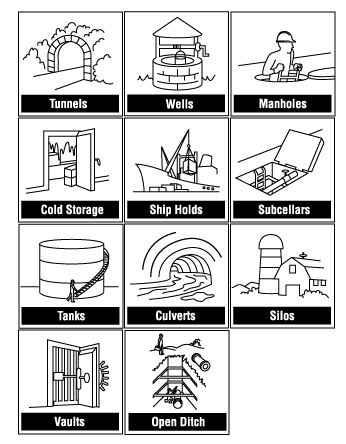This article is intended to assist workers in preparing their Job Safety Analysis (JSA), Job Hazard Analysis (JHA), Activity Hazard Analysis (AHA), Activity Hazard Analysis Template, or JSA Worksheet by providing some starting points to confined space regulations from a variety of counties and regulatory agencies around the globe.
Many, if not most, countries have confined space regulations because of the large number of workers who are injured or killed working in confined spaces. The Canadian Centre for Occupational Health & Safety (CCOHS) states that All jurisdictions within Canada have regulations dealing with confined space entry. The regulations can vary slightly from jurisdiction to jurisdiction. An overview of CCOHS confined space requirements can accessed using this link.

Examples of Confined Spaces Image Credit
Australia has published a Model Code of Practice for confined spaces and a good starting point to find information about confined spaces in the U.K. is the Health and Safety Executive (HSE).
Even though the regulations vary, the basic definition of a confined space is the same regardless of the agency and are similar to the way the United States Department of Labor, Occupational Safety and Health Administration (OSHA) defines a confined space which is a space not designed for people but are large enough for workers to enter and perform certain jobs. A confined space also has limited or restricted means for entry or exit and is not designed for continuous occupancy. Confined spaces include, but are not limited to, tanks, vessels, silos, storage bins, hoppers, vaults, pits, manholes, tunnels, equipment housings, ductwork, pipelines, etc.
OSHA uses the term "permit-required confined space" (permit space) to describe a confined space that has one or more of the following characteristics: contains or has the potential to contain a hazardous atmosphere; contains material that has the potential to engulf an entrant; has walls that converge inward or floors that slope downward and taper into a smaller area which could trap or asphyxiate an entrant; or contains any other recognized safety or health hazard, such as unguarded machinery, exposed live wires, or heat stress. OSHA Reference
New Zeeland has issued a guide titled “Planning entry and working safely in a confined space” to the Australian confined space standards that provides a good summary of types of confined spaces, hazards, risks, and mitigation methods that can be used in preparing your Job Safety Analysis.
In the United States some states, such as California, have their own regulations regarding Confined Spaces. The California Department of Industrial Relations, Cal/OSHA, publishes information about their confined space programs including a guide for Confined Space Entry for General Industry.
In California the general requirements for employers to provide an effective Injury and Illness Prevention Program are in Title 8 of the California Code of Regulations (T8 CCR), Section 3203. The specific confined space regulatory requirements for General Industry are in T8 CCR, Article 108, Sections 5156 through 5158. Because confined space work may involve many different hazards, other regulatory requirements may also apply.
An example is Subchapter 7. General Industry Safety Orders, Group 16. Control of Hazardous Substances, Article 108. Confined Spaces.
The above information can assist you in preparing your Job Safety Analysis or Job Hazard Analysis. The information in this article is intended as a starting point to get your Job Safety Analysis discussions started. The specific details for your job or task need to be considered and incorporated into your Job Hazard Analysis along with the regulations that apply to your specific site location.
JSABuilder is a state-of-the-art online job safety analysis app to assist in preparing your Job Hazard Analysis (JHA), Job Safety Analysis (JSA) or Activity Hazard Analysis (AHA). Set up a free trial account today and follow us on Twitter @JSABuilder, where we Tweet about Health and Safety, provide Safety tips, and updates on current Health and Safety topics.
Images, links, brands discussed or displayed in this article are not endorsements or recommendations. They are for illustration of various products and types of products. JSABuilder does not recommend or express any opinion as to the applicability to any given use case or job hazards.